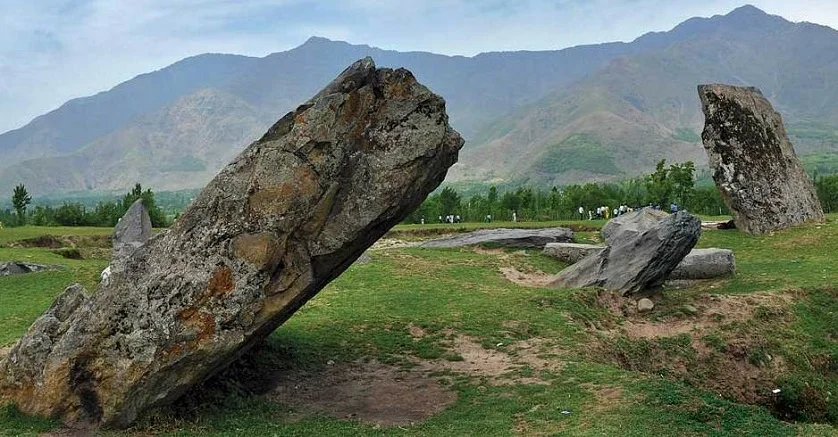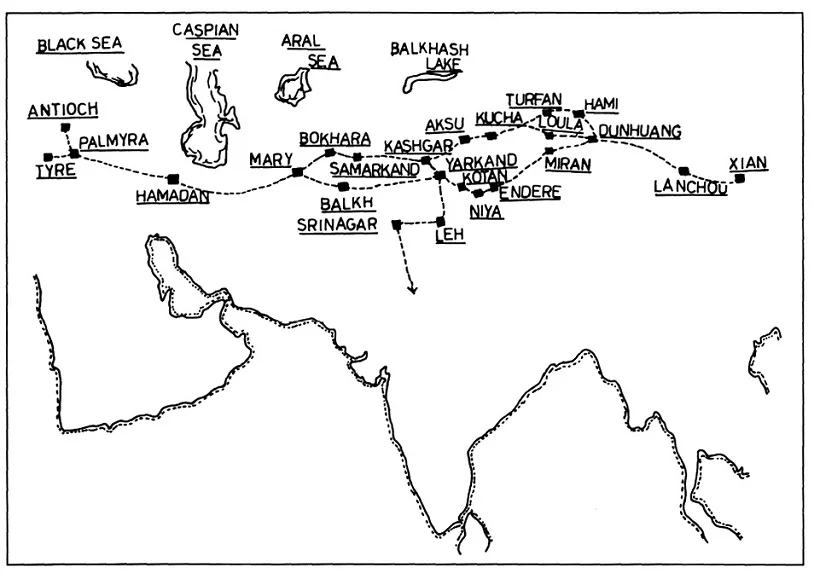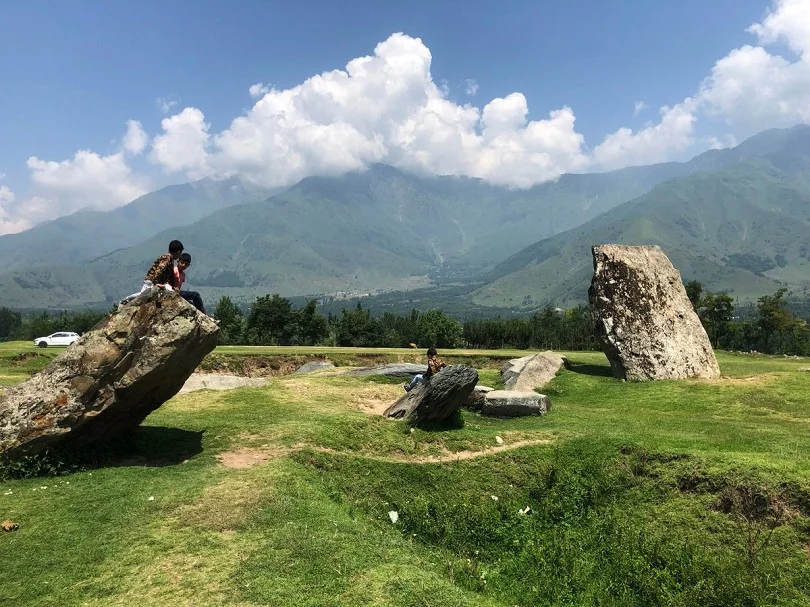
At a time when people are decrying the sad state of archives and other signposts of past, Burzahom awaits the state and societal intervention to uphold its sanctity as Kashmir’s historical site.
By Aaqid Andrabi
UNDER the autumn sun, a swarm of rustic cricketers are locking horns over a highland pitch with historical significance. The ‘turf-war’ played in the garb of the gentlemen’s game is being praised by keen spectators. Some of these cheerleaders are sitting atop big stones which among other things reveal Kashmir’s Central Asia connection.
The adrenaline rush triggers plumes of dust along with an unaddressed anguish over the possible obliteration of Kashmir’s historical link.
“There’s a need to preserve this significant space from further eroding,” says Suhail Bhat, a local history scholar who frequents the ruins for his own research. “It’s one thing to designate this place as protected, but other thing to ensure its preservation.”
Apart from the routine play, there’s fear among Bhat’s tribe that the significant site might lose its status to the growing human habitation around it. “Places like these need extra care and protection,” the scholar says. “They’re our windows of past and our link to civilization.”
A few miles away from the venue, historian Abdal Hassan is blaming the absence of literature for Burzahom’s gradual fading.
Keeping new generation oblivious about their heritage sites, he argues, is accelerating the cultural decay. “I believe conveying the importance of Burzahom shall serve a crucial role to the process of the evolution of humans in general and Kashmiri society specifically,” Hassan says. “It’ll also be fairly advantageous to history as an academic subject in our valley, which unfortunately doesn’t have as many takers.”
People have to start from the beginning to infuse and emphasise a sense of responsibility and drive home the importance of not just Burzahom but various such places of the land, Hassan continues.
“We need to educate our kids from an early stage to understand what it means to discover a part of our past and how it can help us to evolve in our present and the future, too.”
In a bid to boost the sense of history, Hassan says, captive chronicles must be told and retold to make young mindful about the importance of Burzahom.
One such story starts from circa 2075 BCE, when in the Himalayan foothills, the evening is nigh, and the sprawling urban centre of Burzahom is bustling with the hustle-bustle of everyday life. Covering a vast lush green meadow, it’s a foraging community. The ones tasked with gathering food and other essentials are almost done with their chores, ready to settle down around the community fire. The elders and kids are seated—it’s storytime.
One of the elders leads the eager kids surrounding her on a journey, an adventure in her stories, the kids trotting alongside her merrily. The hunters are returning from their quests, on their backs the spoils of the day.
Subterranean pit dwellings of the locals mark the inhabited area. The oval or circular homes dug into the soil, as deep as 6 feet, with long stone celts are narrow at the top and wide at the base, having (wooden) post holes on the ground level suggesting a birch cover protection against the harsh weather. These homes possess a well-defined structure, designated spaces and niches for their respective purposes. Some of the pits are shallower than the others, marked for storage purposes and used as dwellings during warm weather.
This glaringly important historical site came to the fore during a short excavation by DE Terra and T.T Patterson in 1939. However, an extensive excavation project was carried out by T.N Khazanchi of the Archaeological Survey of India (ASI) from 1960-1971. This operation revealed cultures from four varying eras of human civilisation inhabiting the valley: the Neolithic I & II periods, Megalithic period and the Early Historical Cultures (3rd & 4th century Christian Era).

The Burzahom site reveals the intricacies of the evolution of the Neolithic society from a foraging community to one that adopted the land for cultivation purposes and pioneering scientific advances for that era. The artefacts recovered tell a fascinating and layered story of the people, lives and the times they lived. The initial material remains excavated from the site reveal further how the human civilisation in Kashmir came and evolved from the Aceramic Neolithic Age to the Early Christian era to the current age. Finding material remains, such as crude pottery items, still part of the current social setup in the valley, tells the story of the ever-evolving humans.
Apart from pottery, bones and stone tools like harpoons, needles with or without eyes, awls (probably used for stitching skins), spearheads and picks, among other devices, were used by the Neolithic settlers in this period. Besides the use of stone, antlers were typical for tool fabrication. This layer of history reflects a stark absence of any burial system as well as cultivation.
“The Burzahom site in its sense isn’t much relevant to Kashmir valley mainly, concerning its origins or evolution as a social setup, but is more about it being a means to an end to reach the sub-continental plains,” says Saleem Beg, Convener, Indian National Trust for Art and Cultural Heritage, J&K and former Director-General Tourism, J&K.
“When this site must have come into being, the geographies weren’t well-defined enough to establish Kashmir as a particular region. Kashmir fell on the way of their assumed route to the mainland subcontinent.”
The revelations of second period of the Neolithic age ascribe a dramatic evolution of a civilisation that would recently identify as an elementary pool of humans concerned mostly about fundamentals of survival. The artefacts belonging to this period associate evidence of intricate burial processes that had begun to take shape. Graves dug into the house floors and plastered with lime, and bodies placed in them with red ochre on the bones. As many as eleven skulls found with evidence of trepanning, some partial and some complete, mark the cosmic evolution of the Neolithic society delving into more complicated means of medicine and survival techniques.
More significantly, today, one can establish the practice of agriculture through the tools and findings of the palaeo-botanic analysis. Periods I and II provide evidence for wheat, barley and lentil cultivation. The presence of lentils in the Burzahom Neolithic further explains that the people of Burzahom had broad contacts with Central Asia, critical evidence of the human movement through mountain passes into the Kashmir valley.
“About 26 Neolithic sites have been reported from the valley, majorly from Burzahom,” notes SL Shali in his Neolithic Culture in Kashmir with special reference to Central Asia. “Neolithic culture is the earliest known culture of the valley and many traits of this have their parallels on sites in Central Asia.”
At Burzahom, the Central Asian structural similarity is marked by the presence of dwelling pits, oval, rectangular or square in plan, provided with postholes for supporting the superstructure to cover these houses with birch barks.
It’s this connection which makes many believe that Burzahom as a historical landmark needs to be preserved as a signpost of Kashmir’s silk route odyssey.

Back in 2019, a case to revive Central Asian linkages to Kashmir resurfaced when Prime Minister Narendra Modi’s Act East policy and a reach out to Central Asian nations for alternate market exploration gained ground. The move made many in Kashmir optimist about the revival of the historical and cultural link that got buried in the bloodletting partition of 1947.
Keeping the enchanting ruins of Burzahom in mind, many politicians and pundits have been petitioning New Delhi for years now to use the region to seek outreach with Central Asian states. “It’s not impossible to revive these routes even though our geopolitical situation is not conducive enough,” Mehbooba Mufti said as chief minister in 2018 when her government was apparently promoting Kashmir as Gateway of Central Asia. “The way opening the Muzaffarbad road used to seem impossible but this task was achieved finally. Similarly, I feel in days to come when we are working towards finding a way-out for the resolution of the issue of Kashmir issue, opening-up of such routes has an important role to play.”
With its great geostrategic significance, Kashmir was an economic hub, linking South and Central Asia, until the early 20th century. Travellers Hieun Tsang and François Bernier talk about this link in their travelogues. A pile of Persian literature further notes how Ḥāfeẓ-e Shīrāzī would swoon in ecstasy after King Budshah moulded Srinagar on Samarkand model:
Az Shair Hafiz-e-Shirazi Me’Goyand Va Me’ Ruksund / Siyah Chashman-e-Kashmiri Va Turkan-e-Samarkandi
(On Hafiz Shirazi’s melodious poetic notes and tunes / Rock and roll the brave Kashmiris and Samarkand Turks).
But the valley’s deep and distinct Central Asian link got snapped with the dawn of 1947 when the drawing of the Ceasefire Line—which later camouflaged into Line of Control (LoC)—locked the region.

With glaring Central Asian influence, the Neolithic period precedes the Megalithic culture associated with the erection of massive stones or ‘Menhirs’, most probably commemorative establishments at Burzahom. The material culture recovered constitutes gritty redware pottery, manufactured on a potter’s wheel; metal objects and few tools made of bone and stone continued.
Rubble structures associated with the Megalithic men have also been found. The last level of activity at Burzahom ascribes to the early historical period. It is dateable to 3rd-4th century A.D. Mudbrick structures, pottery manufactured on a wheel, and a few metal objects from this era were also found there.
Over the past few decades, this treasure trove of Burzahom has fallen prey to either encroachment by the surrounding populace or systemic neglect at the hands of an indifferent administration, peculating the place of its rarity and historical and cultural significance.
This apathy exists despite Neolithic men leaving their marks at Burzahom. An engraved stone depicts a hunting scene with a human and a dog and a sun path diagram. These delineations of an artist bygone reveal the significance of the place and the need for its immediate preservation.
“Contrary to the public notion, the archaeology department hasn’t forsaken the place or the items discovered from there. Those artefacts of high historical value are intact and preserved in the S.P Museum at Rajbagh, and some are at other physical archives/museums in the country due to the lack of facilities in our union territory,” Saleem Beg says.
“Nonetheless, they’re safe and duly listed in the departmental archives of the ASI. In Kashmir, we lack the attitude needed to preserve and restore such historical places, and the discovered artefacts. Burzahom has, over the years, been infringed upon and its sanctity violated by the local population surrounding the spot. Not to mention the fact that when ASI put in a request of land allotment to establish a museum to showcase its history, the response was lackadaisical, to say the least.”
According to Beg, an on-spot museum is necessary to establish, emphasise and educate the visitors about the importance of the discovered site and its remnants.
An even stranger facet of this mess is the absence of any kind of academic reference to Burzahom in the local curriculum. Be it onwards of primary level right up to the higher education academic literature, Burzahom and its significance has a rather suspicious absence within the academic circles.
Follow this link to join our WhatsApp group: Join Now
Be Part of Quality Journalism |
Quality journalism takes a lot of time, money and hard work to produce and despite all the hardships we still do it. Our reporters and editors are working overtime in Kashmir and beyond to cover what you care about, break big stories, and expose injustices that can change lives. Today more people are reading Kashmir Observer than ever, but only a handful are paying while advertising revenues are falling fast. |
| ACT NOW |
| MONTHLY | Rs 100 | |
| YEARLY | Rs 1000 | |
| LIFETIME | Rs 10000 | |








